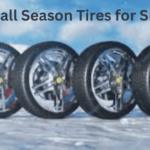Welcome to our comprehensive guide on how to put air in a tire. In this day and age where technology is constantly advancing, it’s essential to stay updated on even the most basic tasks, like maintaining your vehicle.
While it may seem simple, properly inflating your tires is crucial for your safety and the longevity of your vehicle. In this blog post, we will walk you through the step-by-step process of putting air in a tire, ensuring that you have a thorough understanding of the correct techniques and necessary tools required.
So, let’s delve into the world of tire maintenance and equip ourselves with the knowledge needed to handle this essential task with confidence.
Step-by-Step Process to Put Air in a Tire:
Maintaining proper tire pressure is essential for ensuring a safe and smooth ride. Despite being a seemingly simple task, many individuals still struggle with putting air in their new tires.
In this comprehensive guide, we will walk you through the step-by-step process of how to put air in a tire, ensuring that you can confidently tackle this task without any hassle.
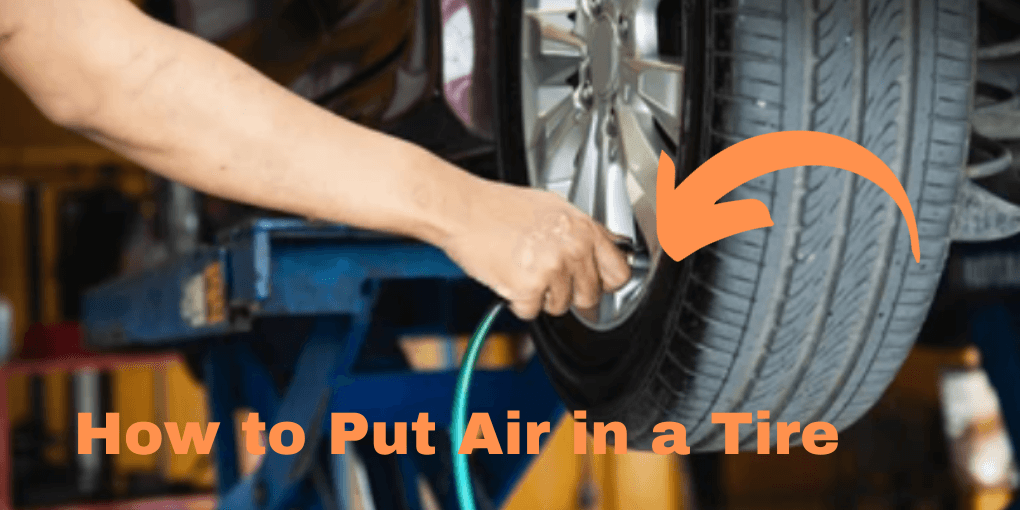
Gathering the Necessary Tools:
Before starting, it is important to gather the necessary tools. You will need a tire pressure gauge, an air compressor, and access to a gas station or any other place that provides air-filling services. It is crucial to have an accurate tire pressure gauge to determine the current pressure of your tires and monitor the inflation process effectively.
Finding the Recommended Tire Pressure:
The next step is to locate the recommended tire pressure for your specific vehicle. This information can be found in your car’s manual, on the driver’s side door jamb, or sometimes even on the fuel filler flap. It is essential to follow the manufacturer’s guidelines, as improper tire pressure can result in reduced fuel efficiency, inadequate braking, or even tire damage.
Checking the Current Tire Pressure:
Once you have obtained the recommended tire pressure, it is time to check the current pressure of your tires. Remove the valve stem cap from each tire and securely attach the tire pressure gauge to the stem. The gauge will provide a reading that indicates the current tire pressure. If the pressure is too low, it is time to move on to the next step.
Filling the Tires with Air:
Using an air compressor, carefully connect the air hose to the valve stem of the tire. Ensure a tight seal to prevent any air leaks. Start the compressor and slowly inflate the tire with air. Periodically check the tire pressure using the gauge while inflating, and stop when you reach the desired pressure. Be cautious not to overinflate the tires, as under-inflation can be just as problematic.
How Much Air to Put in Tires?
In this modern era of transportation, it is essential to understand the basics of maintaining and caring for your vehicle. One crucial aspect of vehicle maintenance is proper tire inflation. Not only does it ensure optimal performance, but it also enhances safety on the road.
In this comprehensive guide, we will walk you through the necessary steps and guidelines for putting air in your tires, starting with determining the correct amount of air to inflate.
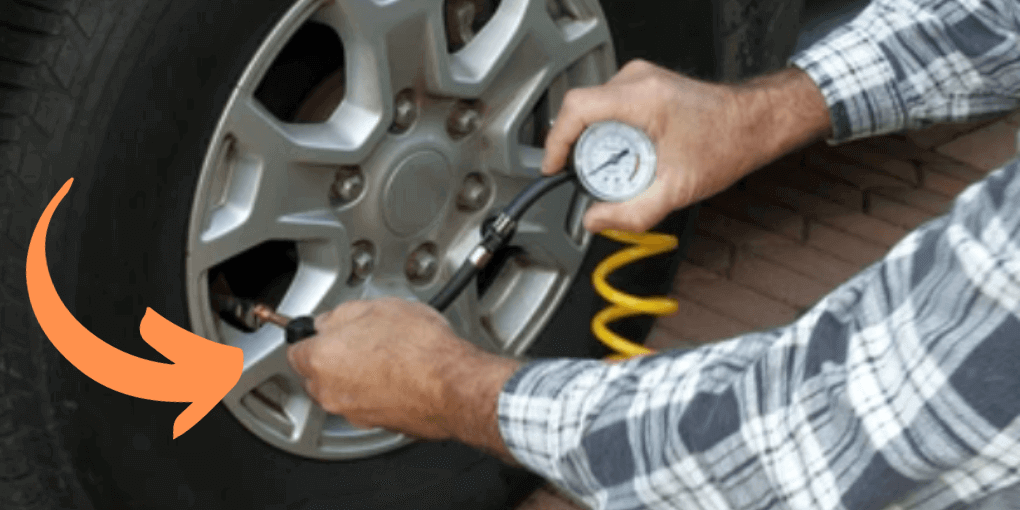
How Much Air to Put in Tires:
Determining the correct tire pressure is vital to guarantee a smooth and safe ride. Each vehicle has a recommended tire pressure value, which can usually be found either in the owner’s manual or on a sticker placed on the driver’s side door jamb.
It is imperative to follow these recommendations as they are specific to your vehicle’s make and model. The recommended tire pressure is measured in pounds per square inch (PSI).
Underinflated tires can cause increased fuel consumption, reduced handling, and premature tire wear. Conversely, overinflated tires can lead to a harsh and uncomfortable ride and may even increase the risk of a blowout or tire failure. Therefore, it is crucial to achieve the optimal tire pressure for your vehicle.
To check the current pressure, you will need a tire pressure gauge. These devices are inexpensive and widely available at automotive stores.
Simply unscrew the valve cap on the tire, place the gauge onto the valve stem, and press firmly to get a reading. If the pressure is lower than the recommended value, it is time to add air.
Adding Air to Your Tires:
To add air to your tires, you will need access to an air compressor or a service station with an air pump. Start by removing the valve cap from the tire you wish to inflate.
Then, press the chuck of the air hose onto the valve stem and ensure a tight seal. Be cautious not to overinflate the tire.
While adding air, it is essential to check the pressure periodically using the tire pressure gauge. This will help you maintain accuracy and prevent over inflation.
If you accidentally add too much air, simply press the center pin of the valve stem with the gauge to release some pressure.
Once you have reached the recommended pressure, quickly remove the chuck and replace the valve cap securely.
Regular Maintenance:
Regularly checking and maintaining proper tire pressure is vital for your vehicle’s overall performance and safety.
It is recommended to check your tire pressure at least once a month and before long journeys. Additionally, fluctuations in temperature can cause tire pressure to change, so it is crucial to pay attention during extreme weather conditions.
By following these comprehensive guidelines, you can ensure that your tires are optimally inflated for a smooth and safe driving experience.
Proper tire inflation not only enhances fuel efficiency and handling but also extends the lifespan of your tires.
Remember, a well-maintained set of tires contributes significantly to your vehicle’s overall performance and your overall safety on the road.
Gather the Required Tools and Equipment:
Hey there, fellow drivers! In today’s blog, we’re going to dive into a comprehensive guide on how to put air in a tire. It may seem like a basic task, but we all need a reminder from time to time.
So, let’s gather the required tools and equipment and get ready to tackle this important maintenance task together!
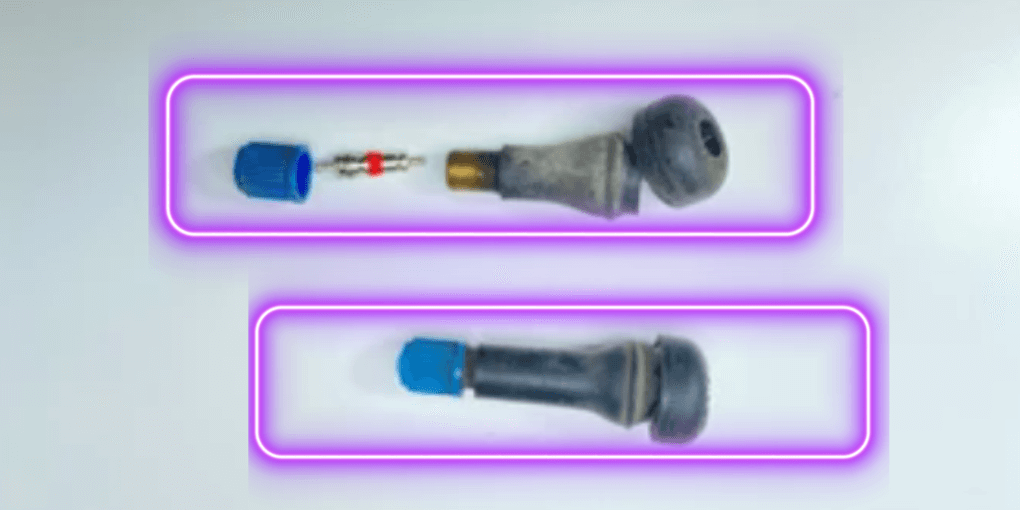
Gather the Required Tools and Equipment:
Before we dive into the actual process, it’s crucial to gather the necessary tools and equipment. Don’t worry; you won’t need anything fancy for this job.
Grab your keys, a tire pressure gauge, a tire inflator or compressor (either portable or fixed), and some spare change, as some air stations may charge a small fee.
Check Your Tire Pressure:
Now that we have the tools at hand, it’s time to check the tire pressure. Start by finding the recommended tire pressure for your specific vehicle.
You can usually find this information on the driver’s side door jamb, inside the fuel filler cap, or in the owner’s manual (which we recommend keeping handy).
Once you have the recommended pressure, use the gauge to check the current pressure in each tire.
Inflating the Tire:
If your tires need some extra air, it’s time to inflate them! First, locate the valve stem, which is usually a small, cylindrical metal protrusion from your tire.
Remove the valve cap and keep it somewhere safe. Attach your tire inflator or compressor to the valve stem by pressing it firmly onto the stem.
You may hear a hissing sound, indicating that air is flowing. Keep a close eye on your tire pressure gauge and add air until you reach the desired pressure.
Check and Adjust Tire Pressure:
Now that you’ve inflated the tire, it’s essential to check the pressure again to ensure you’ve reached the correct level. If necessary, continue adding air until you reach the recommended pressure.
If you accidentally overinflate the tire, don’t panic – simply press down on the valve stem to release some air until you reach the right pressure. Finally, replace the valve cap on the stem.
Locate the Recommended Tire Pressure:
Maintaining the correct tire pressure is crucial for ensuring optimal performance, safety, and longevity of your vehicle’s tires.
Before you can start putting air in your tires, it is essential to locate the recommended tire pressure for your specific vehicle.
This information can typically be found in your vehicle’s owner’s manual or on a sticker located on the inside of the driver’s side door jamb.
The recommended tire pressure is usually measured in pounds per square inch (PSI) and varies depending on factors such as the vehicle’s weight and tire size.
It is important to use the recommended tire pressure as a guide to guarantee optimal tire performance and ultimately, a smoother ride.
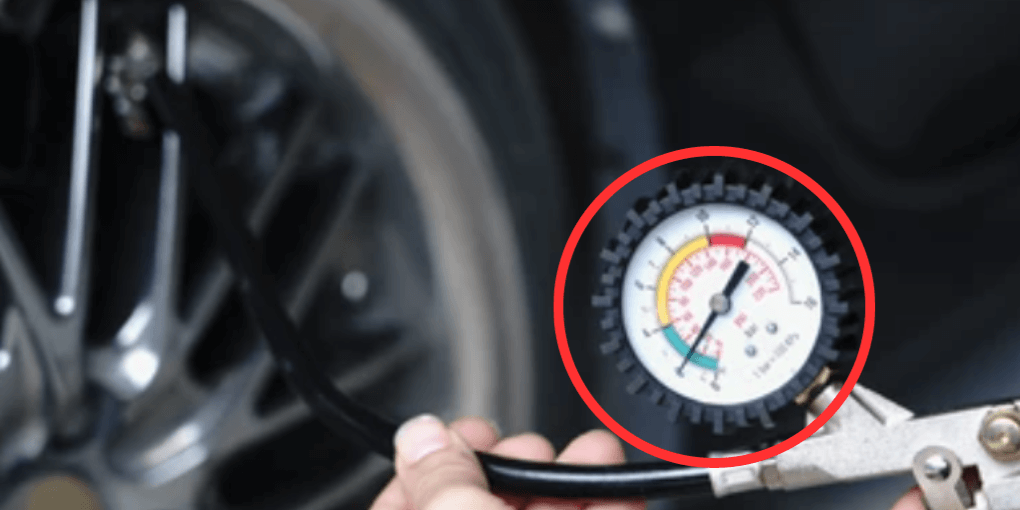
Check for Proper Tools:
Before you proceed with adding air to your tires, ensure that you have the necessary tools on hand.
To inflate your tires, you will need an air pump or compressor, which can be found at most gas stations or purchased for home use.
Additionally, make sure you have a reliable tire pressure gauge, as it is crucial for accurately measuring the current pressure in your tires.
Remember, having the right tools is essential for a successful tire inflation process.
Determine Current Tire Pressure:
To determine the current tire pressure, remove the valve cap from the valve stem on each tire. Attach the tire pressure gauge firmly to the valve stem and press down for a few seconds.
The gauge will provide a reading indicating the current PSI of the tire. Compare this reading to the recommended tire pressure mentioned earlier.
If the current pressure is lower than the recommended pressure, it is time to add air.
Inflating the Tires:
With the proper tools in hand and the knowledge of the desired tire pressure, it’s time to inflate your tires.
Start by connecting the air pump or compressor’s nozzle to the valve stem firmly. Ensure that there are no leaks or gaps between the nozzle and the valve stem to achieve an accurate reading.
Add air in short bursts, checking the tire pressure frequently to avoid overinflating. Keep in mind that overinflating your tires can lead to a harsher ride and potential tire damage, while under inflation can negatively impact fuel efficiency and tire lifespan. Therefore, it is crucial to find the right balance.
How to Find a Suitable Air Source:
When it comes to putting air in a tire, one of the first steps is to find a suitable air source. In 2024, there are various options available for this purpose.
The most common and easily accessible air sources include gas stations and tire shops. Gas stations typically have air pumps that are specifically designed for tires, providing a convenient option for drivers.
Tire shops, on the other hand, may offer more specialized equipment and services.
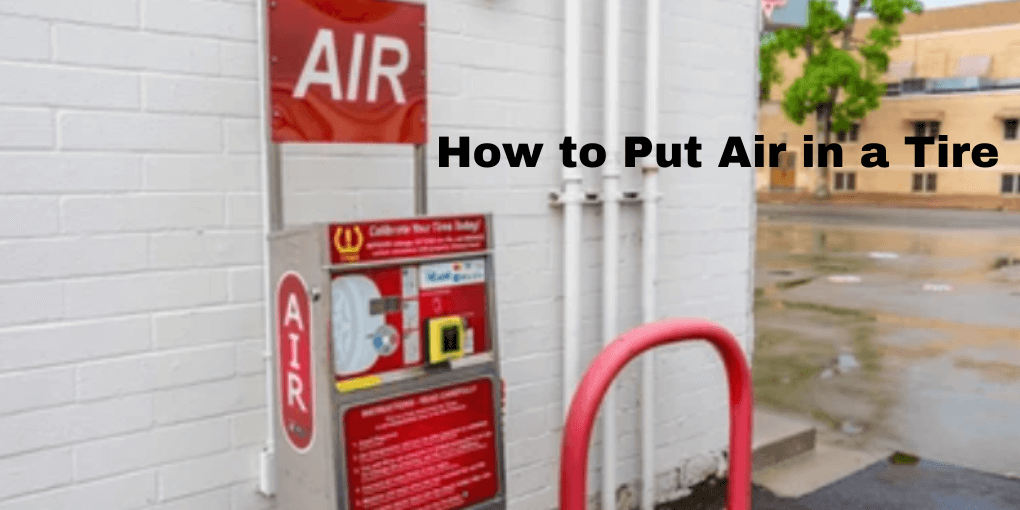
Prepare the Tire:
After locating a suitable air source, the next step is to prepare the tire. This involves removing the valve cap from the tire’s valve stem. The valve cap usually needs to be unscrewed counterclockwise.
It is important to keep the valve cap in a safe place so as not to misplace it. Additionally, it is crucial to inspect the valve stem for any damage or debris.
If there is any dirt or debris present, it can be cleaned gently using a soft, clean cloth.
Attach the Air Hose:
To proceed with putting air in the tire, it is essential to attach the air hose to the valve stem. The air hose can be found at the air source and is generally equipped with a built-in pressure gauge.
While attaching the hose, it is crucial to ensure a tight and secure connection to prevent any air leakage during the process.
Properly align the hose with the valve stem and press it firmly onto the stem.
Inflate the Tire:
Once the air hose is securely attached, it is time to start inflating the tire. Before doing so, it is advisable to refer to the manufacturer’s recommendations for the appropriate tire pressure.
This information is often located on a decal on the driver’s side door jamb or in the vehicle’s manual.
It is important to fill the tire with the correct amount of air pressure to ensure optimal performance and safety.
Monitor the Pressure:
While inflating the tire, it is crucial to monitor the pressure using the built-in pressure gauge on the air hose. The gauge will display the current pressure and allow for adjustments as needed.
It is essential to inflate the tire slowly and in short bursts, periodically checking the pressure to avoid overinflating. Overinflated tires can lead to reduced traction and an increased risk of blowouts.
How to Check the Current Tire Pressure?
Maintaining proper tire pressure is essential for vehicle safety, fuel efficiency, and tire longevity. As a responsible vehicle owner, learning how to put air in a tire is a fundamental skill that everyone should possess.
This comprehensive guideline for 2024 will walk you through the step-by-step process of checking tire pressure and inflating tires, ensuring a smooth and hassle-free experience every time.

How to Check the Current Tire Pressure:
Before inflating your tires, it is crucial to check their current pressure using a reliable tire pressure gauge. Follow these steps to accurately measure the tire pressure:
Prepare the gauge:
Select a pressure gauge that is compatible with your tire valves, as there are different types available. Remove the valve cap from the tire and attach the gauge to the valve stem firmly.
Read the pressure:
Ensure the gauge is correctly inserted and press firmly against the valve stem to get an accurate reading. Be attentive and hold the gauge steady until the reading stabilizes. Note down the reading for each tire.
Compare with recommended pressure:
Refer to your vehicle’s owner manual or the placard on the driver’s side door jamb to identify the recommended tire pressure. Compare the measured pressure with this figure to determine if any adjustments are necessary.
How to Inflate Tires:
Once you have identified the need for adding air to your tires, follow the subsequent steps:
Find a suitable air source:
Locate a nearby gas station or service station equipped with an air compressor. Ensure they provide accurate gauges to avoid over-inflation.
Park properly:
Park your vehicle in a way that allows easy access to all tires. Engage the parking brake and switch off the engine to maintain safety during the inflation process.
Inflate the tires:
Attach the air hose nozzle to the valve stem, ensuring a secure connection. Gradually add the required amount of air in short bursts and periodically check the tire pressure to avoid over inflation. Use the pressure gauge to monitor the changes until you reach the recommended pressure.
The following comprehensive guidelines, you are equipped with the knowledge and steps necessary to check and inflate your vehicle’s tires effectively.
Regularly monitoring and maintaining proper tire pressure will not only enhance your safety on the road but also contribute to better fuel efficiency and extended tire life.
Remember to periodically check and adjust tire pressure as external factors like temperature changes may affect it. Safe travels!
Should You Put Air in Warm or Cold Tires:
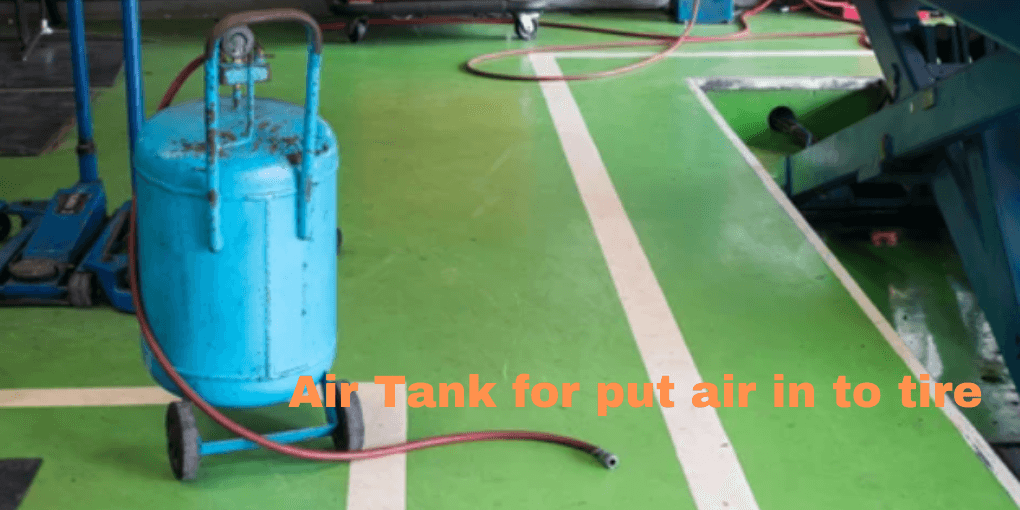
One of the most common maintenance tasks for a vehicle owner is to regularly check and inflate the tires.
While it may seem like a simple task, there are certain factors to consider to ensure the proper inflation and safety of your tires.
One question that often arises is whether to put air in warm or cold tires. This comprehensive guide in 2024 will shed light on this topic and provide you with the necessary information to make an informed decision.
Before delving into the question, it is important to understand that tires can heat up when the vehicle is in motion, leading to a slight increase in tire pressure.
This is why it is generally advised to check tire pressure when the tires are cold. In other words, before embarking on a drive or at least three hours after the vehicle has been in operation.
By doing so, you can get an accurate reading of the tire pressure and ensure that it is within the recommended range.
When it comes to adding air to the tires, the general rule of thumb is that it should be done when the tires are cold.
This is because the heat generated while driving can cause the air inside the tires to expand, leading to higher pressure readings.
If you were to add air to warm tires, there is a high possibility of overinflating them, which can result in reduced traction, decreased tire life, and even a blowout in extreme cases.
However, there may be certain situations where you are on the road and need to inflate a tire that has heated up due to driving.
In such cases, exercise caution and make sure to measure the pressure frequently while adding air. It is advisable to add a little bit of air at a time, allowing the tire to cool down slightly before checking the pressure again.
Repeat this process until the desired pressure is reached, keeping in mind the recommended pressure specified by the vehicle manufacturer.
To summarize, it is generally recommended to put air in cold tires to obtain accurate pressure readings and avoid overinflating them.
However, in emergency situations or when you are on the road, you can add air to warm tires with caution and by monitoring the pressure closely.
Regularly checking and maintaining the proper tire pressure is vital for your safety and the longevity of your tires.
By following this comprehensive guideline in 2024, you can ensure that you are well-equipped with the knowledge to perform this simple yet significant maintenance task effectively.
How to Put Air in a Tires With a Compressor:
Maintaining the correct tire pressure is essential for ensuring a smooth and safe driving experience. It not only improves fuel efficiency but also enhances tire performance and longevity.
In this comprehensive guide, we will walk you through the process of putting air in your tires using a compressor, an efficient and commonly available tool in 2024.

Gather the Necessary Equipment:
Before beginning, gather the necessary equipment for this task. You will require an air compressor, a tire pressure gauge, and an inflation chuck suitable for your specific tire valve type.
It is important to ensure the equipment is of good quality and in proper working condition to guarantee accurate results.
Prepare the Compressor:
Start by preparing the air compressor for use. Check the manufacturer’s instructions to familiarize yourself with the equipment.
It is crucial to ensure the compressor is turned off and unplugged before connecting it to a power source.
Attach the inflation chuck to the air hose, securely fastening it to prevent air leakage.
Check the Current Tire Pressure:
Using a reliable tire pressure gauge, measure the current air pressure in your tires. It is recommended to check all four tires individually, as they may vary.
Refer to your vehicle’s manual or the sticker placed in the driver’s side door jamb to determine the correct tire pressure for your vehicle.
Note the current pressure for each tire as it will help you identify any significant changes later.
Inflate the Tires:
Carefully attach the inflation chuck to the tire valve and ensure a secure connection. Switch on the air compressor and allow it to build pressure.
Once ready, slowly add air to the tire, periodically checking the pressure with the gauge.
It is important to avoid overinflating the tire, so maintain caution and add air in small increments. Remember, it is easier to add more air than to release excess pressure.
Verify and Repeat:
Once you have reached the recommended tire pressure, verify the pressure using the tire pressure gauge. If necessary, make slight adjustments using the compressor.
After completing this process for all four tires, double-check that each tire is inflated to the recommended pressure.
Also, ensure that the inflation chuck is detached properly, and the air compressor is switched off and disconnected from the power source.
By following these comprehensive guidelines, you can stay on top of your tire maintenance by putting air in your tires using a compressor.
Remember, maintaining the correct tire pressure is an integral part of responsible vehicle ownership, and this simple task can help ensure your safety on the road while enhancing your vehicle’s performance.
How to Remove the Valve Stem Cap:
In order to properly inflate a tire, the first step is to remove the valve stem cap. The valve stem cap protects the valve from dirt and debris, ensuring it functions properly.
To remove the cap, simply twist it counterclockwise using your fingers. If the cap is difficult to remove, you may need to use a pair of pliers or a valve stem tool to loosen it.
It is important to handle the valve stem cap with care and avoid losing it as it is essential for maintaining the integrity of the valve.
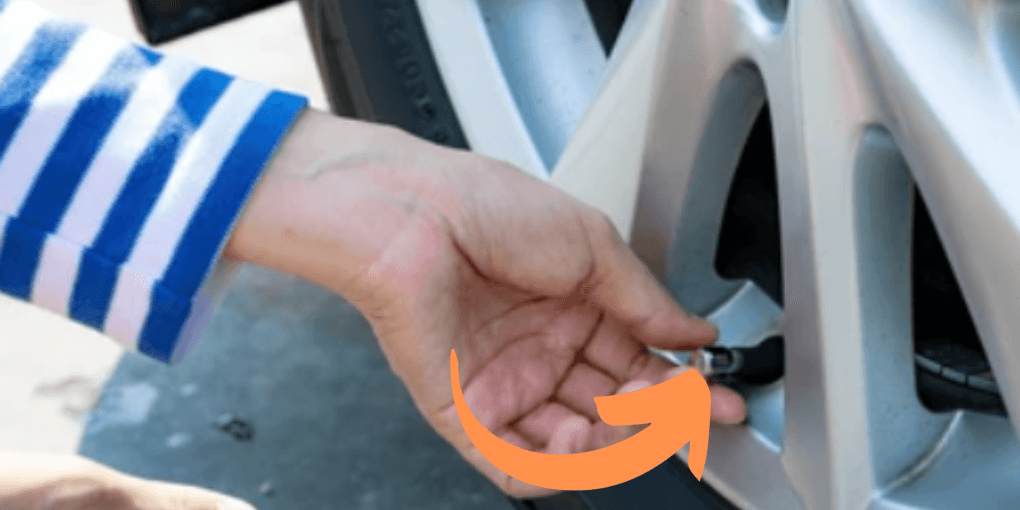
How to Connect the Air Hose:
Once the valve stem cap is removed, the next step is to connect the air hose to the valve stem. The air hose is typically equipped with a pressure gauge to monitor the tire pressure.
To connect the hose, align the nozzle with the valve stem and press it firmly onto the stem. You may hear a small hiss of air escaping, indicating that the connection is secure.
Ensure that the hose is properly aligned and seated, as any air leaks can affect the accuracy of the pressure reading and hinder the inflation process.
How to Inflate the Tire:
With the air hose securely connected to the valve stem, it’s time to inflate the tire. Start by checking the recommended tire pressure for your vehicle.
This information can usually be found in the owner’s manual or on a sticker located inside the driver’s side door jamb.
Set the pressure on the air compressor according to the recommended PSI (pounds per square inch). Once the desired pressure is set, turn on the compressor and allow the tire to inflate. Keep an eye on the pressure gauge to ensure you do not exceed the recommended pressure.
Once the tire is fully inflated, turn off the compressor and disconnect the hose from the valve stem.
How to Reinstall the Valve Stem Cap:
After inflating the tire to the correct pressure, it is important to reinstall the valve stem cap. This small-cap protects the valve from dust, moisture, and debris that can cause damage over time.
Simply twist the cap clockwise onto the valve stem until it is tight. Take care not to over tighten as this can strip the valve stem and lead to air leaks.
It is always a good idea to double-check the cap’s tightness before driving.
Final Tips and Precautions:
When putting air in a tire, it is important to follow a few final tips and precautions to ensure safe and accurate inflation.
Regularly check the tire pressure to ensure it stays within the recommended range and avoid under or over-inflation, which can lead to premature tire wear or blowouts.
Additionally, never inflate a tire that is damaged or worn beyond its safe limit. If you notice any cracks, bulges, or punctures, it is best to have the tire inspected by a professional.
Lastly, always make sure to properly store the air hose and close the valve stem cap tightly to prevent air leaks and maintain optimal tire pressure.
By following this comprehensive guideline, you can confidently put air in your tires, promoting better fuel efficiency, tire longevity, and overall safety on the road.
Remember, maintaining proper tire pressure is a crucial aspect of vehicle maintenance, and regular checks and inflations are simple yet important tasks that every car owner must undertake.
FAQs About the “How to Put Air in a Tire”
The purpose of a tire inflation guide is to provide drivers with a comprehensive understanding of the importance and process of properly inflating their vehicle’s tires.
It serves as a valuable resource to ensure safe, efficient, and optimal driving conditions.
First and foremost, the guide emphasizes the significance of maintaining proper tire inflation. Adequate tire pressure is crucial for several reasons.
One of the primary concerns is safety. Underinflated tires can lead to decreased traction, longer braking distances, and an increased risk of accidents, especially in poor weather conditions.
Overinflated tires, on the other hand, reduce the contact area between the tire and the road, resulting in compromised handling and stability.
By following the tire inflation guide, drivers can avoid these potential hazards and drive with peace of mind.
The guide outlines the step-by-step process of putting air in a tire. It educates users on gathering the necessary tools, such as a tire pressure gauge and air compressor, and familiarizes them with the recommended tire pressure specific to their vehicle.
By providing these instructions, the guide empowers drivers to take proactive measures to maintain their tire pressure at the appropriate level.
Furthermore, the guide emphasizes the impact of proper tire inflation on fuel efficiency. Underinflated tires increase rolling resistance, which results in decreased fuel economy.
By regularly checking and inflating tires to the recommended pressure, drivers can enhance their vehicle’s fuel efficiency and save money at the pump.
Additionally, the tire inflation guide may include useful tips and best practices for maintaining optimal tire pressure.
It may recommend regular tire pressure checks, especially before long trips or during extreme temperature changes, as tire pressure fluctuates with temperature.
The guide may also stress the importance of monitoring tire pressure monthly and keeping spare tires properly inflated for emergencies.
In conclusion, the tire inflation guide serves the purpose of educating drivers on the significance of maintaining proper tire pressure.
It provides a detailed, step-by-step process for inflating tires correctly, emphasizes safety and fuel efficiency, and offers valuable tips for ongoing tire pressure maintenance.
By following this guide, drivers can ensure their tires are properly inflated, resulting in a smoother, safer, and more cost-effective driving experience.
Here is a step-by-step process for putting air in a tire:
Step 1: Gather the necessary tools and equipment:
Before beginning, ensure you have the following items: a tire pressure gauge, an air compressor or access to a gas station air pump, and valve stem caps.
Step 2: Determine the recommended tire pressure:
Check your vehicle owner’s manual or look for a sticker inside the driver’s door jamb, glove box, or fuel filler flap. It will provide the recommended tire pressure in PSI (pounds per square inch).
Step 3: Prepare the tire and valve stem:
Remove the valve stem cap by twisting it counterclockwise and set it aside in a safe place. Inspect the valve stem for any debris or damage.
Step 4: Check the current tire pressure:
Use a tire pressure gauge to measure the current pressure of the tire. Insert the pressure gauge securely onto the valve stem and press down firmly. The gauge will provide a reading of the tire pressure.
Step 5: Inflate the tire:
Attach the air compressor hose securely to the valve stem. If using a gas station air pump, locate the nozzle and press it onto the valve stem. Begin adding air to the tire.
Step 6: Monitor the tire pressure:
As you inflate the tire, periodically check the pressure using the tire pressure gauge. Stop adding air once the pressure reaches the recommended level. Be cautious not to overinflate the tire.
Step 7: Recheck the tire pressure:
After inflating the tire, remove the hose or nozzle and check the tire pressure once again using the pressure gauge. Ensure it matches the recommended pressure.
Step 8: Replace the valve stem cap:
Screw the valve stem cap back onto the valve stem in a clockwise direction. Make sure it is tight and secure.
Step 9: Repeat the process for other tires:
Follow the same steps outlined above for each tire on your vehicle, including the spare tire if applicable.
By following this step-by-step process, you can properly put air in a tire, ensuring it is at the recommended pressure.
Remember to regularly check your tire pressure and maintain optimal inflation for safe and efficient driving.
The guide plays a crucial role in promoting safe and efficient driving by providing essential knowledge and instructions for maintaining proper tire inflation. Here’s how it helps ensure safe and efficient driving:
Enhanced Traction and Handling: Properly inflated tires offer optimal traction and handling capabilities. This guide educates drivers on the importance of maintaining the recommended tire pressure, which ensures that the tires have the correct amount of contact with the road surface.
With adequate traction, vehicles can safely navigate turns, corners, and various road conditions without compromising control.
Improved Braking Performance: Well-inflated tires contribute to improved braking performance. Underinflated tires require a longer braking distance, increasing the risk of accidents, especially in emergency situations.
By following this guide and regularly checking and inflating tires to the recommended pressure, drivers can ensure their vehicles are equipped with optimal braking capabilities, enhancing safety on the road.
Fuel Efficiency and Cost Savings: Proper tire inflation positively impacts fuel efficiency. Underinflated tires increase rolling resistance, which leads to decreased fuel economy.
By adhering to the recommended tire pressure outlined in the guide, drivers can maximize their vehicle’s fuel efficiency, ultimately saving money at the pump.
Extended Tire Life: Maintaining proper tire inflation helps extend tire life. Underinflated tires experience uneven wear patterns, leading to premature tread wear, reduced tire lifespan, and the need for more frequent replacements.
By following the tire inflation guide, drivers can ensure even wear across the tire surface, promoting longer-lasting tires and cost savings in the long run.
Reduced Risk of Tire Failure: Properly inflated tires reduce the likelihood of tire failures such as blowouts, sidewall damage, or other tire-related issues.
By regularly checking and maintaining the recommended tire pressure, drivers can minimize the risk of sudden tire failures, which could lead to accidents or vehicle breakdowns on the road.
By providing guidelines on achieving and maintaining proper tire inflation, this guide equips drivers with knowledge and practices that directly contribute to safe driving habits, improved vehicle handling, increased fuel efficiency, extended tire lifespan, and overall peace of mind on the road.
It acts as a valuable resource for drivers seeking to enhance their driving experience through safe and efficient tire inflation practices.
The tire inflation guide is designed to be suitable for all types of vehicles. Regardless of whether you drive a car, SUV, truck, motorcycle, or any other vehicle with pneumatic tires, this guide provides fundamental principles and instructions that are universally applicable. Here’s why the tire inflation guide is suitable for all types of vehicles:
Emphasis on Manufacturer Recommendations:
The guide emphasizes the importance of following the tire pressure recommendations provided by the vehicle manufacturer.
These recommendations take into account the specific characteristics and requirements of each vehicle model, ensuring optimal performance, handling, and safety.
Whether you drive a small sedan, a rugged off-road vehicle, or a sports car, adhering to the manufacturer’s tire pressure guidelines is essential.
Universal Tire Pressure Units:
The guide uses PSI (pounds per square inch) as the standard unit for measuring tire pressure. PSI is the most widely used unit of measurement for tire pressure across different vehicles.
No matter what type of vehicle you own, the guide’s instructions and recommendations in PSI can be easily applied and followed.
Common Tire Inflation Techniques:
The guide explains the step-by-step process for inflating tires, which involves connecting an air source to the valve stem and monitoring the pressure.
This technique applies to all types of vehicles with pneumatic tires, regardless of their size, construction, or purpose.
Safety and Efficiency Benefits:
The principles and practices outlined in the guide, such as maintaining proper tire inflation, checking tire pressure regularly, and following recommended guidelines, apply universally to all vehicles.
The safety and efficiency benefits of proper tire inflation are essential for all drivers, regardless of their vehicle type.
These benefits include improved traction, better handling, enhanced braking performance, fuel efficiency, extended tire life, and reduced risk of tire failure, which are relevant to drivers of any vehicle.
The tire inflation guide is designed to be suitable for all types of vehicles. Its emphasis on manufacturer recommendations, use of universal tire pressure units, common tire inflation techniques, and the universal safety and efficiency benefits of proper tire inflation make it applicable and beneficial for drivers of cars, SUVs, trucks, motorcycles, and any other vehicles equipped with pneumatic tires.
Following the tire inflation guide, certain tools and equipment are essential for ensuring accurate and effective tire inflation. Here are the specific tools and equipment required:
Tire Pressure Gauge: A reliable and accurate tire pressure gauge is necessary to measure the current tire pressure accurately. Choose a gauge with a clear display and proper calibration to obtain precise readings.
There are various types of gauges available, including digital and analog options. Select one that suits your preference and ensure it is in good working condition.
Air Compressor or Air Pump: An air compressor or access to a gas station air pump is crucial for adding air to your tires.
An air compressor is a convenient option if you prefer inflating tires at home or when on the road, whereas gas station air pumps are readily available for public use.
Ensure the air compressor or pump you use has sufficient pressure and a nozzle that fits securely onto the valve stems of your tires.
Valve Stem Caps: Although not essential for the tire inflation process itself, valve stem caps play a crucial role in protecting the valve stems from debris, dust, and moisture.
These caps help maintain the integrity of the valve stems and prevent air leakage. It is advisable to have spare valve stem caps handy in case any of the existing ones are damaged or lost.
It is important to note that the specific tools and equipment required may vary slightly depending on the type of vehicle or personal preference.
For instance, some vehicles may require specific adapters or extensions for their valve stems. However, the tire inflation guide typically focuses on these core tools and equipment, which are necessary for most standard vehicles.
By having the tire pressure gauge, air compressor or pump, and valve stem caps readily available, you can effectively and accurately measure and adjust the tire pressure according to the recommended levels outlined in the guide.
These tools ensure that you maintain proper tire inflation, leading to enhanced safety, improved fuel efficiency, and prolonged tire lifespan.
This tire inflation guide is specifically designed to be beginner-friendly, catering to individuals with no prior knowledge or experience in tire inflation. Here’s why this guide is suitable for beginners:
Comprehensive Instructions: The guide provides step-by-step instructions, ensuring that each stage of the tire inflation process is clearly explained.
It breaks down the procedure into simple, easy-to-follow steps, making it accessible for beginners. Furthermore, the guide uses straightforward language, avoiding technical jargon or complex terminology that could confuse beginners.
Visual Illustrations: Visual aids, such as diagrams or images, are often included in the guide to enhance understanding and clarity.
These visuals assist beginners in visualizing the steps and components involved in the tire inflation process.
By providing a visual representation, the guide helps beginners grasp the concepts more easily.
Emphasis on Safety: Safety is a key aspect addressed in the tire inflation guide. It highlights the importance of maintaining proper tire pressure for safe driving.
The guide explains why underinflated or overinflated tires can be hazardous and how to avoid these risks.
By prioritizing safety concerns, the guide ensures that beginners understand the significance of proper tire inflation.
User-Friendly Format: This guide is structured in a user-friendly format, with key information highlighted and organized logically.
It provides an introduction to tire inflation, followed by a clear sequence of steps to follow.
The guide may also include frequently asked questions or troubleshooting tips to address any common concerns beginners may encounter.
Troubleshooting Guidance: In case beginners encounter any issues or challenges during the tire inflation process, the guide may offer troubleshooting guidance.
This helps beginners understand potential problems and provides solutions to overcome them.
By including troubleshooting tips, the guide supports beginners in troubleshooting and resolving common issues they may face.
This tire inflation guide is crafted explicitly with beginners in mind. With comprehensive instructions, visual illustrations, a focus on safety, a user-friendly format, and potential troubleshooting guidance, the guide equips beginners with the necessary knowledge and guidance to successfully inflate tires.
By following the step-by-step instructions, beginners can feel confident in their ability to perform tire inflation accurately and safely.
Yes, the tire inflation guide provides valuable information on recommended tire pressure levels. Here’s how the guide addresses this crucial aspect:
Emphasis on Manufacturer Recommendations:
The guide emphasizes the significance of following the tire pressure recommendations provided by the vehicle manufacturer.
It highlights that different vehicles have varying tire pressure requirements based on their make, model, and weight distribution.
The guide encourages users to refer to their vehicle owner’s manual or look for a sticker inside the driver’s door jamb, glove box, or fuel filler flap for the specific recommended tire pressure levels.
Understanding PSI (Pounds per Square Inch):
The guide explains that tire pressure is typically measured in PSI (pounds per square inch), which is the standard unit used to indicate the amount of air pressure within a tire.
It clarifies that PSI is a universal metric recognized by most tires and vehicles, ensuring users understand the terminology and unit of measurement.
Factors Influencing Recommended Tire Pressure:
The guide educates readers on the various factors that influence recommended tire pressure levels.
It explains that factors such as vehicle load, driving conditions, temperature, and tire size can impact the ideal tire pressure.
By understanding these factors, users can comprehend the importance of considering the specific requirements of their vehicle and adjusting tire pressure accordingly.
Regular Pressure Checks:
The guide emphasizes the importance of regularly checking tire pressure to ensure it remains at the recommended level.
It encourages users to incorporate this practice into their routine vehicle maintenance, suggesting monthly checks or before long trips.
By advocating for regular pressure checks, the guide helps users maintain optimal tire pressure levels for safe and efficient driving.
While specific values may not be provided in the guide due to the variability of tire pressure recommendations across different vehicles, it ensures users understand the significance of manufacturer recommendations and the role they play in determining the appropriate tire pressure levels.
By following the guidance in the tire inflation guide regarding recommended tire pressure, users can ensure they are adhering to the specific requirements of their vehicle, resulting in safer and more efficient driving experiences.
Conclusion:
In conclusion, knowing how to properly inflate your tires is essential for safe and efficient driving. By following the step-by-step guide provided in this ultimate guide for tire inflation, you can ensure that your tires are always at the optimal pressure.
Not only does this enhance your vehicle’s performance, but it also contributes to its longevity. Remember to regularly check your tire pressure and inflate it when necessary, as it is a crucial aspect of maintenance that should not be neglected.
By mastering this skill, you are taking a proactive approach towards road safety and vehicle efficiency. So, next time you find yourself needing to put air in a tire, refer to this comprehensive guide and drive confidently.

Sudatta is a passionate automotive enthusiast and expert in the field. With a keen eye for detail and a love for all things automotive, he shares insightful articles and reviews to ignite the automotive passion in readers.



